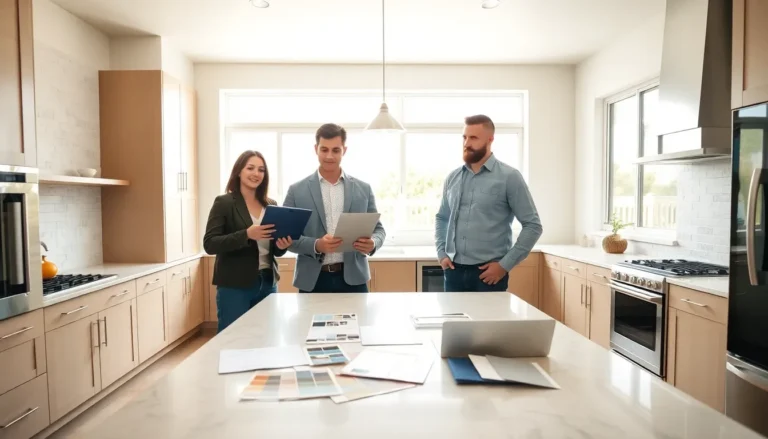Thinking about sprucing up your home? Whether it’s a new kitchen or that long-overdue bathroom remodel, understanding home improvement loan terms can make or break your project. After all, who wants to be knee-deep in renovations while trying to decipher financial jargon?
Table of Contents
ToggleUnderstanding Home Improvement Loan Terms
Understanding home improvement loan terms helps borrowers navigate financing options effectively. Clarity in financial terminology aids in managing renovations smoothly.
Types of Home Improvement Loans
Homeowners can choose from several types of home improvement loans. Personal loans offer unsecured borrowing, allowing flexibility in how funds are used. Home equity loans provide a lump sum based on the property’s equity and typically feature fixed rates. Lastly, government-backed loans, such as FHA Title I loans, support modifications for homes without substantial equity.
Key Terminology Explained
Key terms play a crucial role in reading loan agreements. Annual Percentage Rate (APR) reflects the total cost of borrowing, including fees and interest. Loan-to-Value (LTV) ratio measures the loan amount against the property’s appraised value, influencing loan approval. Additionally, amortization describes how loan payments are structured over time, showing the breakdown of principal and interest. Understanding these terms empowers borrowers to make informed decisions.
Interest Rates and Fees
Interest rates and fees play a significant role when choosing a home improvement loan. Borrowers must grasp these financial components to assess loan costs accurately.
Fixed vs. Variable Rates
Fixed rates remain constant throughout the loan term, providing stability and predictability in monthly payments. Borrowers benefit from knowing their payment amounts won’t fluctuate. Conversely, variable rates can change based on market conditions, affecting overall loan costs. Over time, variable rates may offer lower initial payments, attracting borrowers seeking lower upfront costs. Understanding the implications of fixed versus variable rates empowers borrowers to select the most suitable option for their financial situation.
Common Fees to Consider
Common fees associated with home improvement loans include origination fees, closing costs, and appraisal fees. Origination fees typically cover the lender’s processing costs and can range from 1% to 5% of the loan amount. Closing costs encompass various expenses involved in securing a loan, often totaling 2% to 5% of the loan amount. Appraisal fees assess the property’s market value, ensuring adequate funding for the home improvements. Awareness of these fees helps borrowers prepare for the total financial impact of their loan.
Loan Eligibility and Approval Process
Understanding loan eligibility and the approval process plays a critical role in securing financing for home improvements. Several factors can significantly impact a borrower’s chances of approval.
Factors Affecting Eligibility
Lenders assess various criteria when determining eligibility for home improvement loans. Credit scores significantly influence approval decisions; generally, higher scores lead to better loan terms. Income stability also matters; lenders prefer borrowers with consistent, documented income sources. Property type and value affect eligibility as well; condominiums or multi-family homes may have stricter requirements compared to single-family homes. Debt-to-income ratios impact decisions too; a lower ratio indicates that borrowers manage their debt effectively. Finally, loan amounts and purpose influence the application; lenders often prioritize loans for essential improvements over cosmetic changes.
Documentation Required for Approval
Lenders typically require specific documents for loan approval. Income verification documents, such as pay stubs or tax returns, showcase a borrower’s ability to repay the loan. Credit reports help lenders evaluate creditworthiness, providing insight into past financial behavior. Proof of homeownership, like a mortgage statement or property deed, confirms that the applicant owns the property intended for improvements. Additionally, lenders often ask for estimates from contractors to validate project costs. Closing documents may include identification, such as a driver’s license, ensuring the borrower’s identity. These documents streamline the process and enhance the likelihood of approval.
Managing Your Home Improvement Loan
Managing a home improvement loan involves understanding repayment options and employing strategies to stay on track with payments. This approach ensures a smoother experience during renovations.
Repayment Options
Loan repayment options vary across different types of home improvement loans. Borrowers may encounter fixed monthly payments, which provide consistency and predictability. Variable payments can present opportunities for lower initial costs but may increase over time. Some loans also offer interest-only periods, allowing borrowers to pay just the interest for a set duration before starting principal payments. Additionally, lenders may permit early repayment without penalties, allowing borrowers to save on interest. Understanding these options helps borrowers choose the best repayment strategy for their financial situation.
Tips for Staying on Track
Staying on track with loan payments simplifies project management. First, creating a budget that reflects loan payments ensures funds are available each month. Second, setting up automatic payments can prevent missed deadlines. Third, tracking expenses related to home improvement keeps borrowers informed about their financial standing. Lastly, communicating with lenders when issues arise fosters better relationships and facilitates assistance if necessary. By employing these tips, borrowers can maintain control over their loan repayment.
Navigating home improvement loan terms can significantly impact the success of renovation projects. By grasping essential financial concepts and terminology, borrowers can make informed choices that align with their goals. Understanding the nuances of different loan types and associated costs empowers individuals to select the best financing options for their needs.
Moreover, staying aware of eligibility requirements and the approval process can streamline the journey toward securing funds. With effective management strategies in place, borrowers can maintain control over their repayments and ensure that their home improvement projects proceed smoothly. Ultimately, a well-informed approach to home improvement loans can lead to successful renovations that enhance both living spaces and property value.





